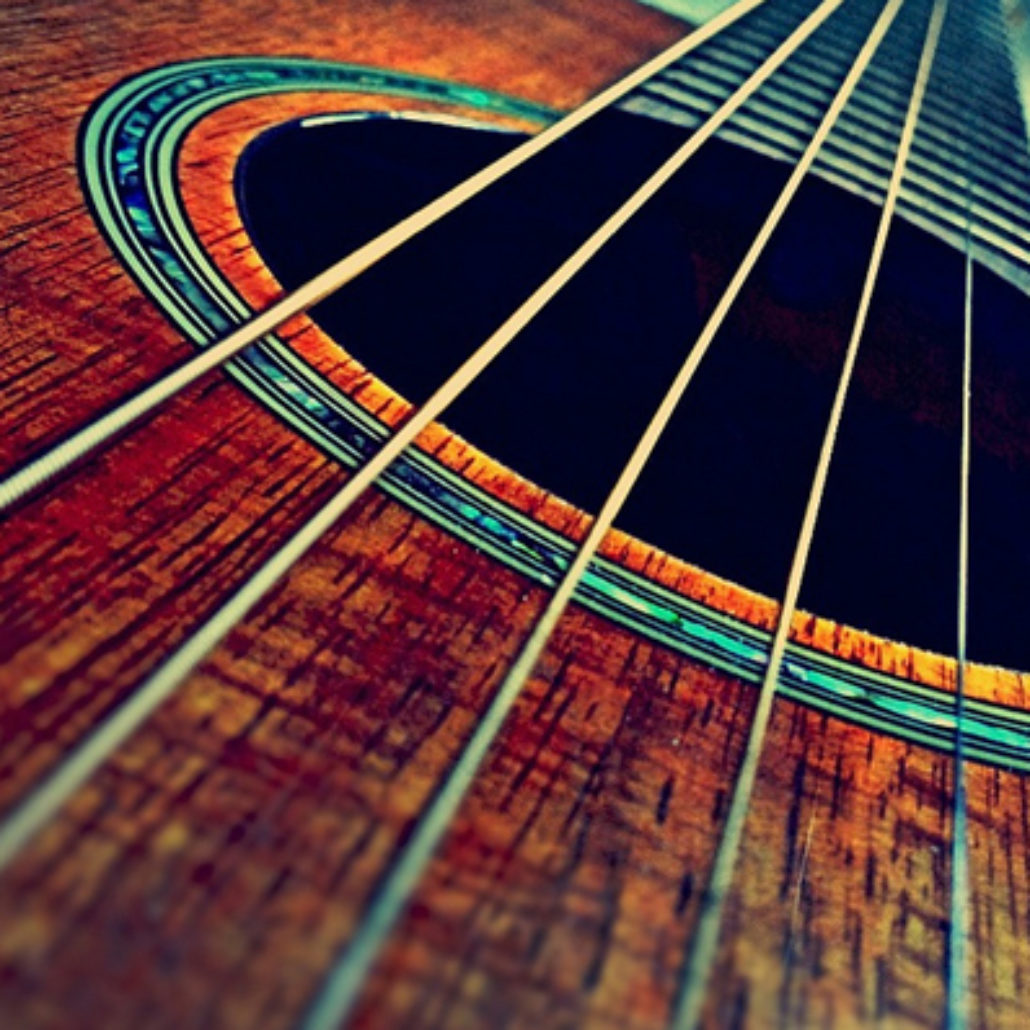A Buying Guide
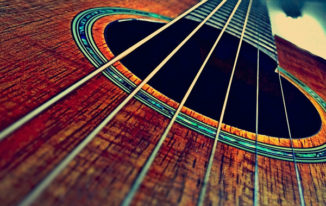
One of the first things we do when we want to learn an instrument is…well…find an instrument to play. So it’s no surprise that when I talk to prospective students, the topic of “what’s best” comes up. There are SO many products on the market today that this article could probably turn into a novel. For length and time purposes, I’ve included the top 5 instruments I normally suggest to my students.
“But wait…how do I know what to look for in an acoustic?” If you’re just starting out, you might not have any frame of reference. Therefore, I put together a little buying guide to help you. Additionally, I have compiled a list comprised of steel string acoustics. You will find no nylon string guitars in this article.
Budget
First thing’s first. Decide on how much you are able and willing to spend on your guitar. If this is your first guitar, you may just want to test the waters and get your feet wet. For most people, this means we don’t want to spend too much money.
If you’re purchasing an upgrade, you need an extra 6-string, or money isn’t an object, I’ve included some models that are a step up. It’s important to note that there are still great guitars to be had at great prices. However, remember that guitars, like anything, do tend to improve the more money you spend on them.
That said, there’s also what I call the point of diminishing returns where, though the quality of the guitar does improve, the bang-for-the-buck begins to drop. We won’t hit that threshold in this article. In a future article, we will discuss some models available if money were no object.
Your size
How tall are you? How big are your hands? How fat are your fingers? Don’t get up in arms about that last comment. I have to ask it. I have students who give the Jolly Green Giant a run for his money and a standard sized guitar just doesn’t work for them.
If you’re a child, you will want a guitar that’s either 1/2 or 3/4 sized. If you are a smaller adult, you need one that is full scale but caters to smaller hands. If you’re an NBA player or a lumberjack, you may need something that has a wider nut and a fatter neck.
Many guitars have a 1 11/16” nut or something similar. This is on the narrower side. For the average jane or joe, this is fine. For the larger individual, I recommend a nut width of 1 3/4” or larger. You’ll get a little more room to fit your fingers between the strings.
Your goals
What are you looking for? For what are you using your instrument? Will it be a travel guitar that you tuck into an over head compartment, or trunk? Will it be a stage instrument? Will you need to be able to plug it into a sound system? All these questions will affect what you want and need in your guitar.
What type of sound do you want?
There’s a plethora of different types of acoustics out there. Each body shape DOES affect the sound produced. Some people disagree with me, but, quite frankly, they’re wrong. Sometimes different body shapes won’t affect the amount of sound produced, but they WILL affect the EQ of an instrument. That means that certain guitars project their highs and lows differently and it’s important to choose the body style that produces the sound that you desire.
Here’s a quick run down of the three most popular body shapes.
Dreadnought
These guitars tend to be better at low-end frequency production. This is not to the exclusion of the high end. The high end is still there, and can be quite punchy through the band mix. This means dreadnoughts are great for flat picking. Think bluegrass, folk, and country.
Grand Auditorium
The GA, as it is informally called, is a guitar that is well-suited for finger style. It has a well-balanced EQ and each string projects nearly equally. I find the GA to produce a nice, “shimmering” quality. A close cousin to the GA is the concert model.
Jumbo
The Jumbo guitar body is LOUD. At least, it can be if it’s made properly. It has the most volume of the three acoustic guitar body types listed here. In that respect, it’s perfect for those night time camp fire serenades. Sonically speaking, you’re not going to get quite as much high end clarity out of the jumbo, but that’s not to say it isn’t present. Jumbos are used quite often for 12 string guitars.
Tonewoods
Oh boy. Here’s a topic where the arguments break out. In this writer’s opinion, wood type DOES affect your tone. In this price range, it’s not going to be earth-shattering. However, solid woods will generally produce more sustain. Additionally, mahogany and rosewood are going to be a bit more mellow and warm while maple and ebony will bring some snap and bite to your sound.
I only mention this here to convey to you that at some point, you’ll progress far enough into your ear training to develop preferences. Once you develop said preferences, you can make a more informed decision. For our current and practical learning purposes, this topic is secondary to other considerations.
Truss rod
This will be short and sweet. Never, under any circumstances, buy an acoustic guitar that does not have a truss rod. I may be one of those crazy people telling you this, but without a truss rod, you wont be able to effectively set up your guitar and the playability will suffer, quite possibly in a major way. Always make sure the guitar you’re considering has a truss rod in the neck.
Acoustic vs. Electric
Do you want to be able to plug into an amplifier? Does getting as loud as possible sound good to you? If you’re going to be playing live and especially with a band, then an acoustic-electric is probably your best bet.
If you’re using this guitar to learn, sticking with a true acoustic might be preferred. True acoustics tend to sustain and resonate a little better. Plus, you never have to worry about batteries. If you’re looking for a no-hassle, no worries guitar, a true acoustic is the way to go.
Now that we’ve looked at some buying tips, let’s check out a few good options for acoustic guitars.
Fender FA100

This Fender is an economy-class gem. It plays well and has good projection and sonic clarity for it’s price. For my students in need of a true budget guitar that doesn’t skimp on sound quality, this is a great guitar.
The real winner here is the strap button on the upper bout. Why? Because with a second strap button, it’s easier to walk around and play guitar. Though there are other methods of adding straps to a guitar, the second strap button offers more stability on the shoulder. Other features include a laminate spruce top, basswood back and sides, a bone compensated saddle for improved intonation, and synthetic bone nut.
Equally wonderful is that this guitar comes in a starter pack with a padded gig bag, a strap, and a Fender clip-on tuner. The rosewood fingerboard makes for a pleasant and warm tone.
On the negative side, this guitar needs to be taken care of. As an economy guitar, it’s important to remember that things may break a little more easily. I recommend regular checkups and guitar care to get the most out of it and help it last a long time.
Additionally, this guitar has a thick coat of paint and polyurethane on the back. It can almost feel plastic. On the flip side, if you’re not worried about nicks and scuffs, the affordability of this guitar makes it a good “beater” instrument.
Pros:
- Budget friendly
- Second strap button
- Full guitar starter package
- High price-to-quality ratio
Cons:
- Needs regular TLC and maintenance
- Feels like plastic
- Hands may stick due to coating
Takamine Jasmine S35
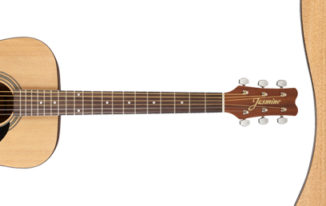
This guitar is a low-cost tone titan. The Jasmine S35 is made by Takamine. Takamine is a great acoustic guitar company with a celebrated history and they brought that expertise over to their Jasmine economy line.
The S35 has a spruce top, Agathis back and sides, rosewood fingerboard and bridge, a synthetic bone saddle and nut, and satin natural finish. Other features include a 25 1/2 inch scale and a 1 3/4” nut. The neck is made of Nato which is the equivalent of eastern mahogany. This helps produce a nice warm tone. However, the S35 also produces a nice bright chime to accompany it’s mellow lows.
What’s great about this guitar is the slim neck. If you’re used to playing an electric, this may be the starter acoustic for you. For beginners, this might help you learn some of the wider chord shapes a little easier. This guitar is also available in a bundle with educational materials
On the negative side of things, this guitar does not come with a second strap button on the upper bout. This means that if you want to use a strap, you will have to buy one with a shoe string or some equivalent to tie around the inside of the strings at the headstock, or have a luthier add one aftermarket. It’s not the end of the world and is still quite useable, so this is simply not optimal.
This guitar has a satin finish and takes a lickin’ very well. If you’re already a musician, this is great for a good ole’ beater guitar that can still rock your socks off.
Pros:
- Budget friendly
- Offered with educational book bundle package
- Extremely high price-to-quality ratio
- Slim neck
- 1 3/4” nut good for large hands, fingers, and fingerstyle playing
Cons:
- No second strap button
- Needs regular TLC and careful handling to retain optimum finish
Epiphone PRO-1 Acoustic Guitar
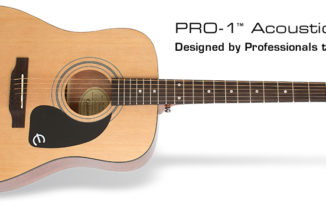
This is a dreadnought shape that’s been slimmed down a bit. Therefore, you don’t have a big bodied guitar to lean over in order to see the frets. Additionally, the Pro-1 has an EZ-profile slim, comfortable C shaped neck that allows for less fatigue on the hand and therefore more time playing.
The PRO-1 is equipped with a pin-less bridge, making string changes a breeze. The graph tech Nu-bone nut is 1 11/16”, so it’s on the slim side if your hands a large, but great for younger players. Also, the guitar is equipped with a select spruce top and select mahogany body.
The frets are wider and taller than those of a normal acoustic. This allows you to more easily make a connection with the frets and therefore requires less pressure from the fingers. Getting into the nitty gritty here, the scale of this guitar is 24.75” which means it’s a full .75” shorter than the standard 25.5” scale of many acoustics. The bottom line? Your fingers and hands stretch less so that you can reach frets more easily.
This guitar is set up for ultra light acoustic strings (9-47). Epiphone did this to reduce the string tension even further so that your hands hurt less after an extended practice session. This guitar is also equipped with a dual action truss rod that makes setups a breeze. Finally, you’ve got a second strap button to let you take your show on the road, making walking or standing and playing a breeze!
This guitar is fantastic. However, it does have a thick plastic coating on it. This saps some sound from the instrument and doesn’t allow for all the resonance potential from the guitar to shine. To be clear, the guitar still has quite a bit of projection and likely more than enough for a learning guitarist.
Also, if you are a larger individual, or you just have big hands, this guitar is going to feel like a toy due to it’s shorter scale (closer frets), and thinner neck. You may want something more in the full size range.
One word of caution would be that because it’s so easy to play, your fingers may not develop as much strength as quickly as you would with other acoustics.
Pros:
- Budget friendly
- Extremely high quality-to-price ratio
- Slim neck
- Extra-low string tension for less hand and finger fatigue
- 24.74” scale for wider finger stretches
- Designed to make playing acoustic guitar as easy as possible
Cons:
- Thick plastic coating reduces some resonance
- Smaller scale may be too tight for larger hands
- Doesn’t build hand strength as quickly as standard acoustics
Recording King ROS-A9M EZ Tone Select Plus All Solid

This guitar is a “000” size, so it’s like a cross between a parlor guitar and a GA. Let me be the first to tell you that though it’s size might be a tad smaller than your standard dreadnought, it packs some major volume. But it doesn’t stop there. This guitar’s sonic profile delivers some real punch! All frequencies are present here.
First, the ROS has a solid Engelmann spruce top. Yes, a SOLID top. That’s almost unheard of in this price range. It also has solid African mahogany back and sides, and a rosewood fretboard. The neck is nato, what some call eastern mahogany, so you benefit from a similar warm and mellow sound.
What’s really cool about this guitar, besides it’s sound, is that it uses the thinnest poly coat possible. Some guitars on this list are covered in a thick coat of paint and polyurethane. Well, not this guitar. This guitar breathes, and is therefore allowed to resonate much more readily. The finish is a satin and you’re hands don’t feel sticky or tacky after a practice session.
The neck is nice and comfortable, with a “C” shaped profile. The satin finish allows your hands to flow effortlessly along the wood. There’s easy access to only 12 frets on this guitar, so if you’re aspiring to play in the upper registers, this may not be the choice for you. For classic blues, 12 frets are right up your alley. The nut and the saddle are both made of bone.
On the negative side, because this guitar uses the thinnest finish possible, it’s more susceptible to nicks and dings. Also, there is no second strap button on the upper bout. Annoying, but not a deal breaker.
Pros:
- Relatively budget friendly
- Extremely high price-to-quality ratio
- Ultra thin satin finish for added resonance, with easy playing neck
- Balanced tonal voice
- Solid wood top, back, and sides
Cons:
- Susceptible to blemishes due to thin finish
- No second strap button
- Easy playability only to the 12th fret
Breedlove Pursuit Concert Series
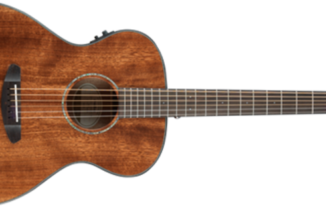
The Pursuit series is a step above the rest as we walk through this list. I recommend this guitar to students when they have been playing a while and their ears have developed a bit. At this point, you are able to appreciate the nuances of tone, feel, and response. However, that doesn’t mean this is exclusively for intermediates as this makes a great gift for the serious beginner who plans to stick with guitar for a long time.
This guitar is a concert body. This series has multiple variations in woods used, but I’ll focus on the one I think really shines: the Pursuit Concert E Series in Mahogany.
This guitar has mahogany back and sides, a mahogany neck, and a solid wood mahogany top. The body is natural gloss and the neck is a semi gloss that allows for smooth playability. A very cool feature of this guitar is it’s pin-less, rosewood bridge. This makes for quicker string changes.
This guitar is equipped with electronics that come in handy. First, it has a built-in tuner that everyone can appreciate. Connected to the guitar’s Fishman pickup is a USB port to connect effortlessly with your recording interfaces and software. A relatively new feature, this is a boon for singer-songwriters.
On the negative side, there’s not much to talk about. The only word of caution is that this guitar isn’t a “wet-your-feet” type of purchase. It’s certainly not the most expensive guitar in the world, but it’s more of an investment. Also, it’s not a package deal, so don’t walk in expecting to get extra picks, strings, or a strap.
Some argue that today’s large port electronics require holes cut into the guitar that stop the vibrations ever so slightly. I think there may be some truth to this, but its nowhere near the affect the naysayers profess a small hole has on resonance.
Pros:
- Extremely high quality-to-price ratio
- Semi-gloss neck for added playability
- Balanced tonal voice
- Solid wood top, back and sides
- Built-in Fishman USB pickup with tuner, EQ and phase switch
- Pin-less bridge
- Comes with gig bag
- Good for intermediates or as a backup guitar
Cons:
- Not a budget guitar
- Not available as a guitar package with picks, strap, etc.
- Has hole cut for electronics
Final thoughts
Whether you’re a beginner or a seasoned player looking for something new, any of these guitars will serve you well. In parting, I suggest that you have a professional perform a setup on your new guitar. Instruct them that you would like low action with no fret buzz and you will have a guitar that plays well and better facilitates your goals of playing and learning. Best of luck to you!
